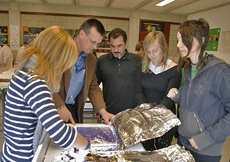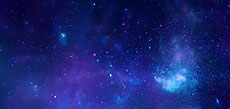|
Have a safe day!
Tuesday, Oct. 26
3:30 p.m.
DIRECTOR'S COFFEE BREAK - 2nd Flr X-Over
THERE WILL BE NO ACCELERATOR PHYSICS AND TECHNOLOGY SEMINAR TODAY
Wednesday, Oct. 27
3:30 p.m.
DIRECTOR'S COFFEE BREAK - 2nd Flr X-Over
THERE WILL BE NO FERMILAB COLLOQUIUM TODAY
Click here for NALCAL,
a weekly calendar with links to additional information.
Upcoming conferences |
|
Tuesday, Oct. 26
- Breakfast: Bagel sandwich
- Creamy turkey vegetable soup
- Chili dog
- Country fried steak
- Chicken cacciatore
- Italian panini w/ provolone
- Assorted sliced pizza
- Super burrito
Wilson Hall Cafe Menu
|
|
Wednesday, Oct. 27
Lunch
- Chicken satay w/ peanut sauce
- Peapods
- Jasmine rice
- Coconut cake
Thursday, Oct. 28
Dinner
- Closed
Chez Leon Menu
Call x3524 to make your reservation. |
|
|
Professional Development expands fall, winter courses
If you're planning to step into a new role or if you just want to upgrade your job skills or strategies, the Professional Development Office has you covered.
The Professional Development Office recently kicked off its fall and winter courses and this time offers more to learn than ever. Course areas for the remainder of 2010 and winter 2011 include leadership and management skills, computing skills and other professional and technical development topics. The offerings also include new management courses, such as adaptive leadership, a course that offers advice on how to approach different individuals with different coaching strategies. Adaptive leadership takes place on Nov. 30. The full course schedule is here.
Barbara Brooks, manager of the Professional Development Office, said that the office added new courses because employees expressed interest in the topics. Also, the skills taught in the courses are needed at the laboratory.
In 2010, nearly 1,200 employees completed 104 internal classes through the Professional Development Office. Brooks hopes that even more employees enroll in the courses offered this year.
“Take advantage of the opportunity to maximize your current skills as a supervisor, project manager or individual contributor," Brooks said. "The Professional Development Office can help you expand your knowledge and skill base through its ongoing development programs." If you or your work unit have specific training needs, please contact Barbara Brooks at bbrooks@fnal.gov. |
QuarkNet reaches out overseas
 |
QuarkNet's Tom Jordan works with physics instructor Christophe Hugou to install a cosmic-ray detector in the Collège Prévessin, a junior high school 50 meters from CERN's Prévessin site. Jordan, previously an employee in the Fermilab Education Office and now with the University of Florida, spent Monday and Tuesday at the junior high school working with the 20 physics workshop students to build, install and analyze data from the detector. QuarkNet has installed 550 cosmic-ray detectors in schools in 19 countries; the detector in the Collège Prévessin was the first to be installed in France. Through a partnership with a neighboring school, students near Lausanne, Switzerland, will also have the chance to work with the cosmic-ray detector. |
|
Fermilab theorist sees dark matter evidence in public data
 |
| The Milky Way's galactic center. A new paper reports that very-high-energy gamma rays coming from the center of the Milky Way originate from dark matter collisions. Image courtesy of: NASA/CXC/UMass/D. Wang et al. |
A Fermilab theorist and his colleague at NYU might have found clues to some of the universe’s juiciest secrets at the center of the Milky Way.
In their analysis of public data from the Fermi Gamma-ray Space Telescope, Dan Hooper, Fermilab scientist, and Lisa Goodenough, a graduate student at New York University, report that very-high-energy gamma rays coming from the center of the Milky Way originate from dark-matter collisions.
“We went out of our way to consider all causes of backgrounds that mimic the signal, and we found no other plausible astrophysics sources or mechanics that can produce a signal like this,” Hooper said.
A recent paper, published on the pre-print server arXiv, outlines their findings.
Astrophysicists have long postulated a wide range of dark matter particles, including axions, super heavy particles and particles that fall in between: Weakly Interacting Massive Particles, or WIMPs.
Read more
|
CALICE goes digital
This weekend, CALICE has opened a new chapter of calorimeter testing: Our first full physics prototype of a digital hadron calorimeter saw its first pions at Fermilab! So, what is this about?
As you know from many previous posts here, the CALICE collaboration develops calorimeter technologies for future experiments based on particle flow event reconstruction. On the hadron calorimeter side, so far we've been looking at a highly granular analog hadron calorimeter: Many small plastic scintillator tiles, each read out with a tiny silicon-based photon sensor, and all that sandwiched between layers of steel absorbers, 38 of them. The "analog" in the name means that each of these cells gives out a signal that is (approximately) proportional to the energy deposited in it by throughgoing particles. By summing up the energy of all cells that saw something, we get the energy of the particle that hit the calorimeter. Of course there are very sophisticated techniques how the "summing up" is done precisely, which results in better measurements. In total, this device has close to 8000 electronics channels, all packed into one cubic meter.
Read more
|
|
|
US-Japan symposium
 |
| Fermilab Director Pier Oddone and KEK Director General Atsuto Suzuki at a US-Japan symposium last week. |
Last week from Wednesday through Friday I attended the symposium to celebrate 30 years of US-Japan collaboration under the US-Japan Agreement on High Energy Physics established in 1979. The agreement was part of the implementation of a broader collaboration on energy signed by President Carter and Prime Minister Fukuda. Notably entrepreneurial physicists like Leon Lederman, Pief Panofsky, Tetsuji Nishikawa, and program managers like Bill Wallenmeyer were quickly out of the gate with an implementing accord. Collaborations under the agreement are funded in different ways in Japan and the US. In Japan there is a fund set aside for these collaborations. Experiments are selected by the director of KEK with advice from a selection committee in response to proposals. These recommendations are reviewed and adjusted by the Joint Committee on the US-Japan Agreement composed of laboratory directors and agency program managers. In the US the collaboration is funded through regular channels in response to proposals to DOE.
During the symposium we reviewed the contributions made by our US-Japan collaboration over the last three decades, discussed future collaborations and presented ideas on how to strengthen our already very close working relations.
My first experience with the value of the US-Japan collaboration under the agreement came in the early 1980s when I was working on the PEP TPC collaboration. A remarkable strong group of postdocs and students led by professor Tune Kamae of the University of Tokyo made key contributions. Today many of those students and postdocs are leaders in the Japanese community. We heard similar stories at the meeting about the many other collaborative activities over the three decades, a most impressive set that has touched nearly all major particle physics discoveries. At Fermilab, Japanese physicists have participated continuously, starting with the bubble chamber program, followed by fixed target experiments like KTev and DONUT and most notably in the CDF collaboration at the Tevatron under the initial leadership of professor Kuni Kondo from Waseda University.
During the three decades the US-Japan agreement has evolved from a position where all the major facilities were in the US, such as the Positron Electron Project at SLAC, the Tevatron at Fermilab and fixed target experiments at SLAC, BNL and Fermilab, to a much more even distribution of facilities. The AMY detector at Tristan broke ground for American groups working in Japan. This was followed by Belle, SuperK and Kamland and in the future we see American groups working in T2K, high intensity kaon and muon experiments at JPARC, and in Super KEKB. US facilities are RHIC, the Tevatron, Fermi/GLAST and high intensity beams at Fermilab for neutrino and rare decay experiments.
Another important component of collaborative work has been in accelerator and detector R&D, most importantly on the triplet magnets for the LHC, on the ILC global R&D under the GDE, and on silicon-based detectors. As we move towards the future there is great common interest in the LHC, the intensity frontier experiments both at Fermilab and JPARC and the technology of future accelerators and detectors.
|
|
Oct. 22-25
- Five stores provided ~59.25 hours of luminosity
- Electron cooling problems
- Store 8199 aborted due to beam valves closing
- Booster vacuum burst
- Booster kicker problem repaired
- Wet engine repaired today, Oct. 25
*The integrated luminosity for the period from 10/18/10 to 10/25/10 was 51.64 inverse picobarns. NuMI reported receiving no protons on target during this same period due to target work.
Read the Current Accelerator Update
Read the Early Bird Report
View the Tevatron Luminosity Charts |
|